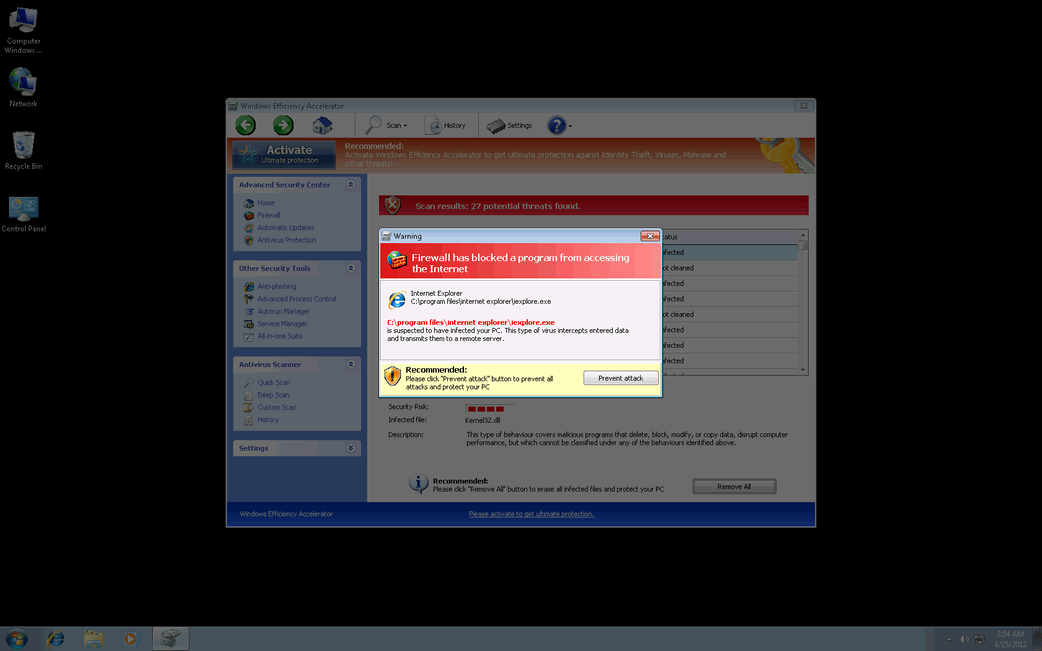Windows Efficiency Accelerator
Threat Scorecard
EnigmaSoft Threat Scorecard
EnigmaSoft Threat Scorecards are assessment reports for different malware threats which have been collected and analyzed by our research team. EnigmaSoft Threat Scorecards evaluate and rank threats using several metrics including real-world and potential risk factors, trends, frequency, prevalence, and persistence. EnigmaSoft Threat Scorecards are updated regularly based on our research data and metrics and are useful for a wide range of computer users, from end users seeking solutions to remove malware from their systems to security experts analyzing threats.
EnigmaSoft Threat Scorecards display a variety of useful information, including:
Ranking: The ranking of a particular threat in EnigmaSoft’s Threat Database.
Severity Level: The determined severity level of an object, represented numerically, based on our risk modeling process and research, as explained in our Threat Assessment Criteria.
Infected Computers: The number of confirmed and suspected cases of a particular threat detected on infected computers as reported by SpyHunter.
See also Threat Assessment Criteria.
| Threat Level: | 100 % (High) |
| Infected Computers: | 5 |
| First Seen: | April 25, 2012 |
| Last Seen: | November 19, 2019 |
| OS(es) Affected: | Windows |

Windows Efficiency Accelerator Image
Windows Efficiency Accelerator is advertised as a reliable security application. However, ESG security analysts classify Windows Efficiency Accelerator as a malware infection; to be specific, malware infections like Windows Efficiency Accelerator are known as rogue security programs. Windows Efficiency Accelerator belongs to the FakeVimes family of rogue anti-virus applications. This malware family has been infecting computers since 2009, and Windows Efficiency Accelerator is only one of dozens of rogue anti-virus programs belonging to this family of malware.
Windows Efficiency Accelerator in particular belongs to a group of FakeVimes rogue anti-virus programs, released in 2012. There are various clones of Windows Efficiency Accelerator in this batch of FakeVimes fake anti-viruses, including such fake security programs as Virus Melt, Presto TuneUp, Fast Antivirus 2009, Extra Antivirus, Windows Security Suite, Smart Virus Eliminator, Packed.Generic.245, Volcano Security Suite, Windows Enterprise Suite, Enterprise Suite, Additional Guard, PC Live Guard, Live PC Care, Live Enterprise Suite, Security Antivirus, My Security Wall, CleanUp Antivirus, Smart Security, Windows Protection Suite, Windows Work Catalyst. These tend to be bundled along with the Sirefef or ZeroAccess rootkit, making them more difficult to remove than a typical FakeVimes infection. If you suspect that your computer system is infected with Windows Efficiency Accelerator or with one of its many clones, ESG security analysts strongly recommend making sure to scan your computer system with a reliable anti-virus program with anti-rootkit capabilities.
Table of Contents
How Criminals Profit from Infecting Your Computer with Windows Efficiency Accelerator
Most rogue anti-virus program scams involve convincing the victims that they must purchase a bogus anti-virus program. To do this, Windows Efficiency Accelerator will spam the victim with alarming, misleading error messages, as well as causing a variety of other symptoms on the infected computer system. These error messages will alert the victim that a number of different Trojans and viruses are attacking their computer system and that only a licensed version of Windows Efficiency Accelerator can fix this problem. To take this lie one step further, Windows Efficiency Accelerator also runs a bogus scan of the victim's hard drive, claiming to have found a large number of different Trojans.
Trying to fix these imaginary problems with Windows Efficiency Accelerator simply results in additional error messages claiming that you will need to "upgrade" Windows Efficiency Accelerator. However, since Windows Efficiency Accelerator has no real anti-virus capabilities, paying for this bogus security program is definitely not a good idea. In order to fool Windows Efficiency Accelerator into thinking that you have paid for it, ESG malware researchers have provided the registration code 0W000-000B0-00T00-E0020. Entering this registration code will stop Windows Efficiency Accelerator from displaying many of its most annoying fake security alerts. However, it is important to remember that this will not remove Windows Efficiency Accelerator, but simply stop its annoying error messages until an anti-virus program is used to remove Windows Efficiency Accelerator completely.












SpyHunter Detects & Remove Windows Efficiency Accelerator

Windows Efficiency Accelerator Video
Tip: Turn your sound ON and watch the video in Full Screen mode.

File System Details
| # | File Name | MD5 |
Detections
Detections: The number of confirmed and suspected cases of a particular threat detected on
infected computers as reported by SpyHunter.
|
|---|---|---|---|
| 1. | Protector-pyqj.exe | c6d040541e5c3a378359698d07e3680b | 3 |
| 2. | Protector-aydv.exe | 0f9c4d58461ef0983e3399ea489c1987 | 1 |
| 3. | %AppData%\NPSWF32.dll | ||
| 4. | %AppData%\Protector-[RANDOM CHARACTERS].exe | ||
| 5. | %AppData%\result.db | ||
| 6. | %CommonStartMenu%\Programs\Windows Efficiency Accelerator.lnk | ||
| 7. | %Desktop%\Windows Efficiency Accelerator.lnk |

